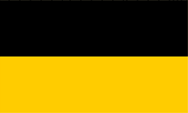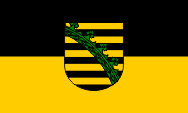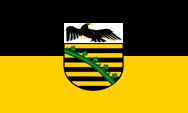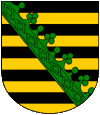Provinz Sachsen |
|
|
|
| Übersicht – Contents: | |
Provinz Sachsen |
|
|
|
| Übersicht – Contents: | |
Flaggen – Flags: |
|
 |
Landesfarben |
 |
1875–ca.1920, |
 |
ca.1922–1934, |
|
|
|
Bedeutung/Ursprung der Flagge – Meaning/Origin of the Flag: |
|||||||||||||||
| Die Farben der Flagge der Provinz Sachsen, Schwarz und Gelb (Gold), haben ihre Wurzeln im sächsischen Wappenschild. | The colours of the flag of the Province of Saxony black and yellow (gold), have their roots in the saxonian blazon. | ||||||||||||||
| Für das Land wurde am 09.01.1817 ein Wappen angenommen, es war das Wappen von Sachsen, zehnfach schwarz-gold geteilt mit grünem Rautenkranz. Im Jahre 1864 wurde das Wappen abgeändert, die Abfolge der Farben im Schild wurde vertauscht, so dass Gold oben lag. Interessanterweise fand dies keinen Niederschlag in der Anordnung der Farben auf der Flagge. Eigentlich müsste auch hier dann Gelb oben gelegen haben. | A coat of arms was adopted for the country on 9th of January in 1817. It was the coat of arms of Saxony, divided ten times between black and gold with a green diamond wreath on it. In the year 1864 the coat of arms was changed. The sequence of colors in the shield became reversed so that gold was on the top. Interestingly, this was not reflected in the arrangement of the colors on the flag. Actually, yellow should have been on top, too. | ||||||||||||||
| Ab 1875 konnten die Provinzen Preußens weitestgehend Selbstverwaltung betreiben. Es gab Provinziallandtage und eine provinziale Regierung (Provinzialausschuss). Jede Provinz hatte ihre Landesfarben, die auch als Flagge verwendet wurden, und auch ein Wappen. Ob die Provinzregierungen ihre Landesfarben-Flaggen für amtliche Zwecke (Dienstflagge) dem einem Wappen belegten ist nicht zweifelsfrei und nicht für alle Provinzen überliefert. | From
1875, the provinces of Prussia could largely operate in self-governing. There
was a provincial parliament and a provincial government (Provincial Committee).
Each province had its own colors (Landesfarben), which were also used as flag,
and they had also their own coat of arms. If the provincial governments put for
official purposes (official flag) their coats of arms on a flag with the provincial
colors is not handed down beyond doubt and not for all provinces.
| Ein
für die Flagge bedeutsames Ereignis war die Machtergreifung durch die
Nationalsozialisten im Deutschen Reich im Jahre 1933. Alle offiziellen
Nicht-Hakenkreuz-Flaggen die auf den Föderalismus, regionale Bezüge oder
das Kaiserreich zurückgingen wurden zwischen
1933 und 1935 abgeschafft.
| Another
incident for the flag was the seizure of power by the National Socialists
in the German Empire in 1933. | All official non-swastika flags, that refered to federalism, regional references or the old German Empire were abolished between 1933 and 1935.
Für die Nationalsozialisten galten die föderale Struktur des Deutschen
Reiches, seine historisch gewachsenen Länder, als überholt, als Relikte
einer zu überwindenenden Vergangenheit.
| In diesem Sinne wurden mehrere Gesetze erlassen, am 31.03.1933 das 'Vorläufige Gesetz zur Gleichschaltung der Länder mit dem Reich', am 07.04.1933 das 'Zweite Gesetz zur Gleichschaltung der Länder mit dem Reich' und schließlich, am 30.01.1934 das 'Gesetz über den Neuaufbau des Reiches'. Die föderale Länder-Struktur des Deutschen Reiches wurde damit durch die Gaue der NSDAP abgelöst, die Länder wurden bedeutungslos. Ämter und Behörden hatten ab jetzt die Hakenkreuzflagge als Dienstflagge zu verwenden, und zwar bis zum 15. September 1935, als mit dem Reichsflaggengesetz eine Dienstflagge für alle Ämter und Behörden des Reiches geschaffen wurde. Die Ministerpräsidenten der Länder, ab spätestens 1933 alle von der NSDAP – und dann meist Reichsstatthalter genannt – blieben jedoch bis 1945 im Amt.
For the National Socialists, the federal structure of the German Empire,
its historically grown countries, was considered as outdated, as relics
of a past to be overcome. |
In this sense, several laws were enacted, on 31st of March in 1933 the 'Provisional Law for the phasing of the countries with the Empire', on 7th of April 1933 the 'Second Law for the phasing of the countries with the Empire' and finally, on 30th January in 1934 the 'Law on the rebuilding of the empire'. Thus, the federal structure of the German Empire was replaced by the gau-structure of the NSDAP, the countries became meaningless. From now on, offices and authorities had to use the swastika flag as official flag, until September 15th in 1935, when by the flag-law was legislated a new created official flag for all the offices and authorities of the empire. The prime ministers of the countries, which latest in 1933 all came from the NSDAP – now mostly called Reichsstatthalter (maybe translated as 'governor') – however remained in office until 1945. In
diesem Sinne wurde dann auch mit den Provinzen des Landes Preußen verfahren.
Ihre hoheitlichen Aufgaben wurden von den Gauen der NSDAP übernommen, die
sich manchmal mit den Grenzen der Provinzen deckten und manchmal neu
geschafen wurden. Die jeweiligen Provinzflaggen verschwanden.
| This
was then also applied on the provinces of the state of Prussia. Their
sovereign duties were taken over by the Gau structure of the NSDAP, which
sometimes coincided with the borders of the provinces and sometimes they
were new created. The respective provincial flags disappeared.
| Die
entsprechenden Landesfarben galten mit Einschränkungen zwar weiter, auf
jeden Fall aber nicht in Form von Flaggen. Sie wurden z.B. vereinzelt an
Uniformen der SA oder bei bestimmten Dienstgraden der Hitlerjugend in
der Brustschnur verwendet.
| The
corresponding country colours continued, with restrictions, but definitly
not in the form of flags. | They were used, for example, occasionally on uniforms of the SA or in some ranks of the Hitler Youth in the breast cord. Nach
dem Krieg wurde die Verwaltung innerhalb des Deutschen Reiches neu aufgebaut,
und zwar lokal, über die Struktur der Länder. Das waren teilweise alte Länder,
teilweise wurden neue Länder geschaffen. Dabei besann man sich oft der alten
Landesfarben und reaktivierte sie – oder man schuf neue – für eingeschränkte
hoheitliche Aufgaben, die der Kontrolle durch die Alliierten unterstanden.
Mit der Gründung der BRD und der DDR
wurde für beide Gebilde eine interne Länderstruktur final festgelegt und es
wurden entsprechende offizielle Flaggen für die Länder eingeführt.
| After
the war, the administration within the German Empire was rebuilt, but locally,
following the structure of the countries. | These have been partly old countries, and some new countries were created. Sometimes they bethought the old country colours and reactivated them – or they created new ones – for limited sovereign duties, which were under the control of the Allies. With the founding of the FRG and the GDR, an internal country-structure was finalised for both entities and corresponding official flags were introduced for these countries. Quelle/Source:
Volker Preuß,
Jürgen Kaltschmitt,
Uniform-Fibel,
Deutsche Wappen Rolle |
| |||
Wappen – Coat of Arms: |
|
 |
1817–1864, Wappen Provinz Sachsen – coat of arms of Province of Saxony, Quelle/Source: Deutsche Wappen Rolle |
 |
1864–1920(?), Wappen Provinz Sachsen – coat of arms of Province of Saxony, Quelle/Source: Deutsche Wappen Rolle |
 |
1920(?)–1922(?), Wappen Provinz Sachsen – coat of arms of Province of Saxony, (zweifelhaft – doubtful), Quelle/Source: Jürgen Kaltschmitt |
 |
1920(?)–1933 Wappen Provinz Sachsen – coat of arms of Province of Saxony, Quelle/Source: Jürgen Kaltschmitt |
|
|
|
Bedeutung/Ursprung des Wappens – Meaning/Origin of the Coat of Arms: |
|
| Das Wappen der Provinz Sachsen hat seine Wurzeln im sächsischen Wappenschild. | The coat of arms of the Province of Saxony has its roots in the saxonian blazon. |
| Die preußischen Könige aus dem Hause Hohenzollern nutzten die Verdienste ihres Landes um die Befreiung Deutschlands von Napoleons Herrschaft um sich durch reichliche Gebietsgewinne zu entschädigen. Sie annektierten Danzig, Posen, die Altmark, Gebiete in Westfalen und am Niederrhein. Sie hofften sich auch ganz Sachsen einverleiben zu können, dessen König an der Seite Napoleons tragisch scheiterte. Sein Großherzogtum Warschau war auch schon zwischen Preußen und Russland aufgeteilt worden. Letztlich beschränkte sich Preußen darauf, große Stücke aus dem sächsichen Kuchen herauszuschneiden, große Gebiete Sachsens im Norden, Nordwesten und Nordosten zu annektieren und mit der Altmark zum "Herzogtum Sachsen" zu vereinen, der späteren "Provinz Sachsen". Für das Land wurde am 09.01.1817 ein Wappen angenommen, es war natürlich das Wappen von Sachsen, zehnfach schwarz-gold geteilt mit grünem Rautenkranz. Im Jahre 1864 wurde – zur besseren Unterscheidung vom Königreich Sachsen (der Zorn gegen das Land schien sich gelegt zu haben) – das Wappen abgeändert, die Abfolge der Farben im Schild wurde vertauscht, so dass Gold oben lag. Interessanterweise fand dies keinen Niederschlag in der Anordnung der Farben auf der Flagge. Eigentlich müsste auch hier dann Gelb oben gelegen haben. | The
Prussian kings of the house of Hohenzollern used the merits of their
country to liberate Germany from the reign of Napoleon, to compensate for
themselves by making ample territorial gains. They annexed Danzig (Gdansk), Posen (Poznan),
the Altmark, areas in Westphalia and on the Lower Rhine. They hoped also to
be able to incorporate whole Saxony, whose king tragically failed at
Napoleon's side. His Grand Duchy of Warsaw had already been divided between
Prussia and Russia. At last, Prussia limited itself by cutting large pieces out of the Saxon cake, annexing large areas of Saxony in the north, northwest and northeast and uniting them with the Altmark to form the "Duchy of Saxony", the later "Province of Saxony". A coat of arms was adopted for the country on 9th of January in 1817. It was of course the coat of arms of Saxony, divided ten times between black and gold with a green diamond wreath on it. In the year 1864 the coat of arms was changed – to better distinguish it from the Kingdom of Saxony (the anger against the country seemed to have subsided) – the sequence of colors in the shield became reversed so that gold was on the top. Interestingly, this was not reflected in the arrangement of the colors on the flag. Actually, yellow should have been on top, too. |
| Quelle/Source: Volker Preuß, Deutsche Wappen Rolle | |
Landkarte – Map: |
|||
|
|||
| Die historische Landkarte zeigt die Provinz Sachsen zwischen den Jahren 1815 und 1866, in roter Umrandung. | The
historical map shows the province of Saxony between the years 1815 and 1866,
within a red border. | ||
Zahlen und Fakten – Numbers and Facts: |
|
|
|
|
|
|
|
|
|
|
|
|
Geschichte: |
|
1816 · Bildung der Provinz Sachsen aus folgenden Gebieten: • Gebietsabtretungen des Königreichs Sachsen an Preußen • die preußischen Gebiete Altmark und Magdeburg • die ehemals zu Mainz gehörenden Besitzungen Erfurt und Eichsfeld 1944 · Teilung der Provinz Sachsen in die Provinzen Magdeburg und Halle-Merseburg, Regierungsbezirk Erfurt zu Thüringen 1945 · Vereinigung der Provinzen Magdeburg und Halle-Merseburg, mit dem Land Anhalt zum Land Provinz Sachsen - Anhalt |
History: |
|
1816 · creation of the Province of Saxony from the following
territories: • from the Kingdom of Saxony to Prussia ceded territories • the Prussian territories Altmark and Magdeburg Town • the formerly to Mainz belonging possessions Erfurt Town and Eichsfeld 1944 · partition of the Province of Saxony into the Provinces of Magdeburg and Halle-Merseburg, the Governmental District of Erfurt came to Thuringia 1945 · unification of the Provinces of Magdeburg and Halle-Merseburg, with the country Anhalt to the country Province of Saxony - Anhalt |
| Quelle/Source: Atlas zur Geschichte, Volker Preuß, Discovery '97 |
Ursprung des Landesnamens – Origin of the Country's Name: |
|||||
| Der Name der Provinz geht auf jede Landesteile zurück, die im Jahre 1816 als Gebietsabtretungen des Königreichs Sachsen an Preußen gegeben wurden, und die den größten Teil der Provinz ausmachen. Die Altmark, Magdeburg, Erfurt und das Eichsfeld wurden zusätzlich noch angegliedert. | The
name of the province goes back to that territories, which were ceded from the
Kingdom of Saxony to Prussia in 1816, which is the bigest part of the provinze.
The Altmark Area, the town of Magdeburg and the town of Erfurt and the Eichsfeld
Area were additionally annexed.
|
Quelle/Source: Volker Preuß |
| |||